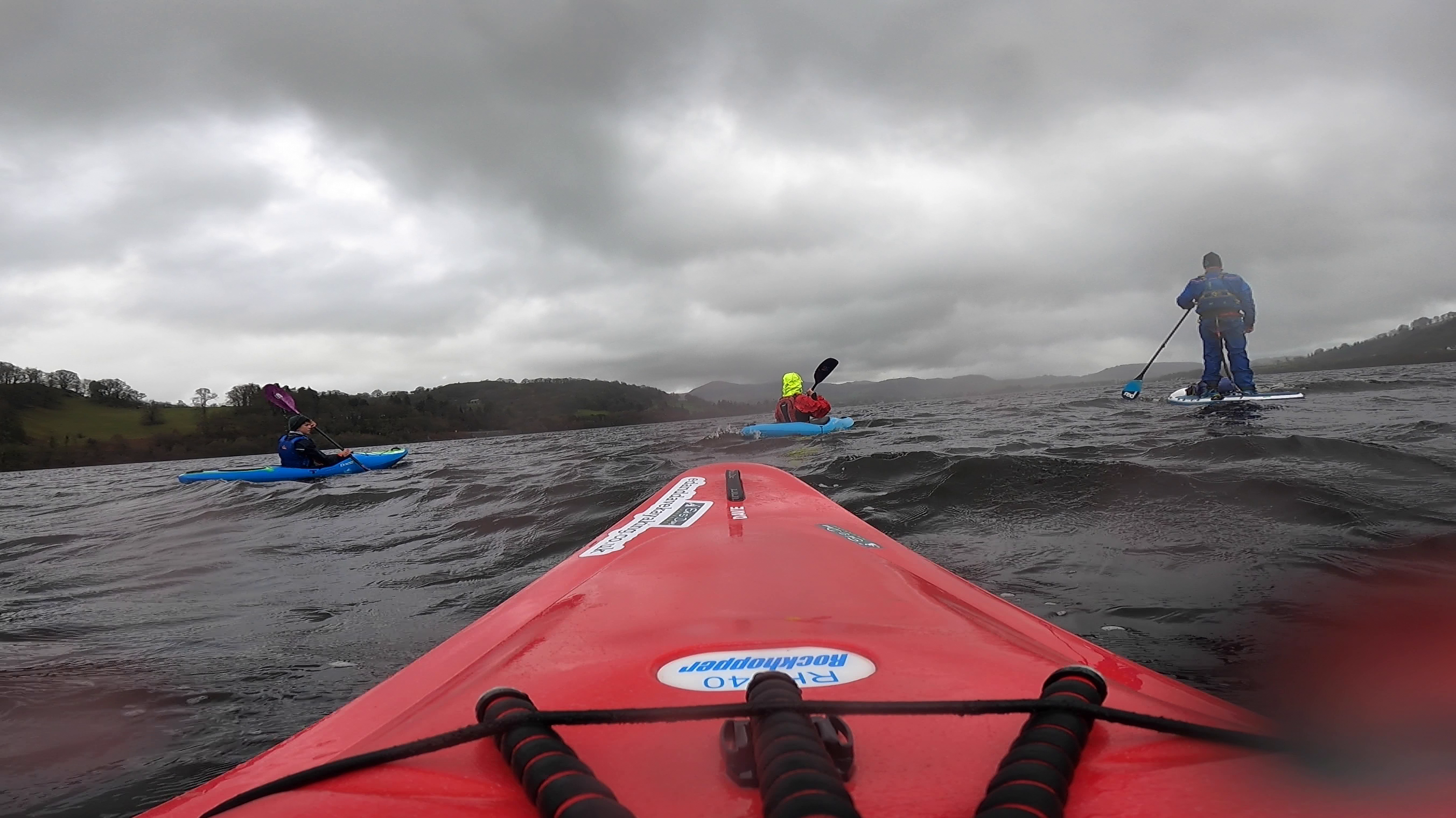How to paddle in the wind
When you are out on your trips, whether on the river, lakes or the sea, chances are you will be affected by the wind. Learning how to paddle in the wind will make your trips safer and take less effort.
As part of your trip planning, you will have consulted the predicted weather on the day in question. It's good to check the physical weather the day before and on the day too as forecasts can be wrong. A quick look out the window will tell you most of what you need to know.
Do also find yourself a good weather site or phone app that gives up to date weather monitoring including the metrics given below.
Here are some you could try:
https://www.windy.com/-Waves-waves
 A canoe on the lake. Notice the chop on the water from the wind and the lean on the canoe.
A canoe on the lake. Notice the chop on the water from the wind and the lean on the canoe.Key metrics to measure wind
When thinking about how to paddle in the wind, there are four key metrics to consider:
Strength - This is how strong the wind is and is measured in a speed unit such as knots or metres per second.
Direction - This is the direction FROM which the wind is blowing. It is usually given as a compress direction eg. Northeast, North, South etc.
You can find out more about how wind is measured by going here.
Gusts - This shows how strong the wind is gusting in wind speed. Gusts can be troublesome especially on open water or near trees that may be blown over.
Timings - This is a profile of the way the wind will change strength and direction over the course of a day. The more data points during the day you have, a better weather profile you will get. Obviously the weather can change ON the day too so you will need to factor these changes in too.
 Wind chart showing the wind changing over a period of hours. The colour coding makes it easy to see problem areas
Wind chart showing the wind changing over a period of hours. The colour coding makes it easy to see problem areasWhen paddling your craft - either kayak, canoe or SUP, the effects of wind will be different in each. The specific attributes of the craft will also change the effects. A longer craft with skeg or fins may be less affected than one that is shorter with no skeg or fins.
A canoe, having a higher profile above the water, will be strongly impacted by wind. A paddleboard being paddled in a kneeling position may be less impacted.
As you are paddling, you may need to make adjustments to ensure you can continue the trip especially when paddling into the wind. These adjustments might be:
- Changing your paddling strokes - The wind may slow your craft and you may need to dig deeper on strokes or use different ones to maintain control of your craft.
- Changing the angle of the craft - Pointing your craft into the wind may make it easier to paddle. This may result in a series of zig zags in order to maintain your route.
- Using objects as cover - Shielding your craft from the wind is a good way to make progress. Shifting behind trees, extended banks or man made objects can make significant differences.
- Changing the route - If the wind is very strong, you may choose to change your route to make it easier. In extremes, you may have to abort the trip.
- Changing craft - In a group scenario, you may want to change paddlers to craft they are more familiar with and more capable in. This can be done on the water or on the bank depending on skill levels.
- Change your seating position - In canoes and SUP's, taking a position that is lower in the craft reduces the risks of a capsize from the wind. Kneeling lowers your centre of gravity. In extremes, you can bend your torso lower so long as you can still paddle. These will also take more of your body out of the wind which helps too.
- Trim your craft - Moving the weight in your craft towards the front or rear of the craft, depending on wind direction, will help to hold the position in the wind when paddling. It will lower the bow of the craft in the water which will reduce the effects of the wind.
Wind chill factor
With an increase in wind, comes a change in temperature especially during inclement weather.
You may be working harder to progress with your craft, but you should also be aware of how cold you are getting.
Wind often creates water spray which may be landing on your clothes or face.
Add in the chill from the wind speed and this can become uncomfortable or even dangerous.
A lowering of body temperature for you or a member of the group should be monitored and steps taken to avoid hypothermia.
The steps may include adding more clothing, having a warm drink, seeking warm shelter and increasing body movement.
 Paddling into the wind on Bala Lake. Note the waves and Chris on the SUP
Paddling into the wind on Bala Lake. Note the waves and Chris on the SUPPositive effects of wind when paddling
There are some positives from an increase in wind.
Paddling with the wind behind you gains a push and makes paddling easier. In warm weather, it provides a cooling breeze too.
In canoes, you can use sails to propel your craft. This is a great skill to learn and reduces the effort needed. Sails are particularly useful on lakes and open water.
An increase in wind can make for an interesting trip and it is certainly something you need to experience and learn to deal with.
PS. Paddlesports can be dangerous.
Read our safety disclaimer - here

New paddling inspiration, tip, trip or technique video EVERY week! Watch Ed, Dave and Moo on their kayaking, canoe and SUP adventures. It's all about safely having fun on the water. 200,000+ views, 110+ videos & 900+ subscribers so far! Click below to start watching:
Ed & Dave Kayaking Youtube Channel
WANT TO HELP US?
We really value your visit to us today. We run this website and our Youtube channel to provide paddling inspiration, tips, trip and technique content to you. We love being out on the water! If you enjoyed your visit, you can support us by using the links below:
Buy us something on our wish list
Thank you
NEED WEB HOSTING?
We recommend IONOS. Great service, technical support and stable hosting. Click the link below to find out more:
IONOS Web Hosting - RECOMMENDED!



